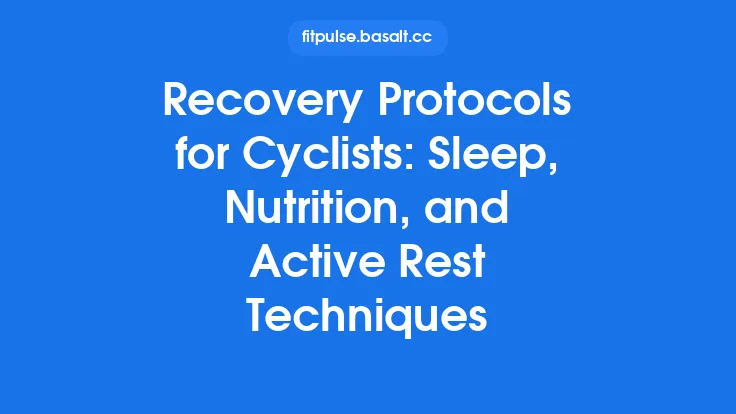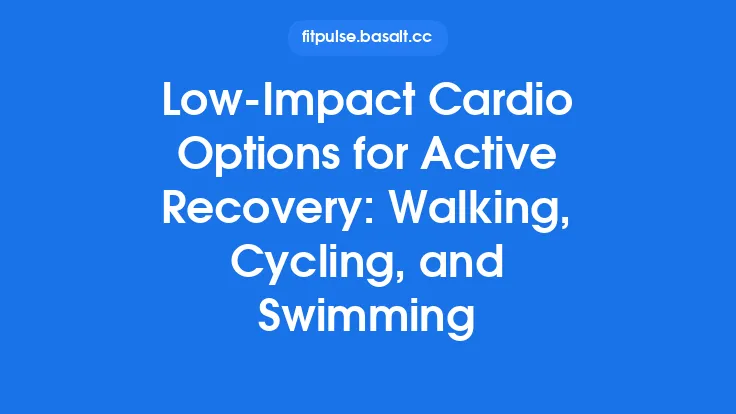Snow sports place unique physiological demands on athletes. The combination of high‑intensity bursts, prolonged aerobic efforts, and exposure to cold environments creates a distinct recovery challenge. While training periodization, strength development, and mobility work are essential pillars of performance, the ability to restore tissue integrity, clear metabolic waste, and reset the nervous system after a day on the slopes can be the deciding factor between a plateau and a breakthrough. This article delves into three evidence‑based recovery modalities—ice baths, compression, and active rest—exploring the science behind each, practical implementation guidelines, and how they can be woven into a comprehensive recovery plan for skiers, snowboarders, and other winter‑sport athletes.
Ice Bath Therapy
1. Physiological Rationale
Cold‑water immersion (CWI) triggers vasoconstriction, which reduces blood flow to the immersed tissues. This constriction limits the influx of inflammatory mediators and edema‑forming fluids that accumulate after high‑impact or high‑intensity efforts such as mogul runs, aerial landings, or sprint intervals on a ski track. When the athlete exits the water, a reactive vasodilation—often called the “reperfusion effect”—floods the muscles with oxygen‑rich blood, facilitating the removal of metabolic by‑products (lactate, hydrogen ions) and delivering nutrients needed for repair.
Key mechanisms include:
| Mechanism | Effect on Recovery |
|---|---|
| Reduced tissue temperature (10‑15 °C) | Slows enzymatic activity, limiting secondary muscle damage |
| Decreased nerve conduction velocity | Lowers perceived soreness and pain |
| Modulation of inflammatory cytokines (e.g., IL‑6, TNF‑α) | Attenuates prolonged inflammation |
| Enhanced parasympathetic activation | Promotes faster heart‑rate recovery and better sleep quality |
2. Evidence Summary
Meta‑analyses of CWI across sports consistently show modest reductions in delayed‑onset muscle soreness (DOMS) 24–48 h post‑exercise and small improvements in short‑term performance (e.g., sprint repeatability). In snow‑sport contexts, studies on alpine skiers have reported lower CK (creatine kinase) levels and faster restoration of quadriceps strength after a 10‑minute, 12 °C immersion following a simulated race.
3. Practical Protocols
| Variable | Recommended Range | Rationale |
|---|---|---|
| Water temperature | 10–15 °C (50–59 °F) | Balances sufficient cooling without excessive discomfort or risk of hypothermia |
| Immersion depth | Up to the iliac crest (hip level) | Ensures major lower‑body muscle groups are treated |
| Duration | 8–12 minutes per session | Sufficient to trigger vasoconstriction; longer exposures provide diminishing returns and increase cold‑stress risk |
| Frequency | Immediately post‑session, up to 2–3 times per week | Aligns with training load; avoid daily CWI if training intensity is low to prevent blunting of adaptive signaling |
| Post‑immersion | Active re‑warming (light movement, warm clothing) for 5–10 minutes | Promotes vasodilation and accelerates metabolic clearance |
4. Implementation Tips for Snow‑Sport Athletes
- Portable setups: Collapsible tubs or insulated barrels can be filled with cold water on‑site at ski resorts. Adding ice packs or using a chiller unit helps maintain target temperature despite ambient warmth in indoor facilities.
- Timing with altitude: At high‑altitude training camps, the body’s thermoregulatory set‑point may be altered. Slightly warmer water (15 °C) can be used to avoid excessive cardiovascular strain.
- Integration with other modalities: Pair CWI with gentle dynamic stretching after re‑warming to restore range of motion without re‑inducing inflammation.
Compression Therapy
1. How Compression Works
Graduated compression garments (GCGs) or pneumatic compression devices apply external pressure that is highest distally (e.g., ankle) and gradually decreases proximally (e.g., thigh). This pressure gradient assists venous return, reduces capillary filtration, and limits interstitial fluid accumulation. In the context of snow sports, where athletes often experience micro‑trauma from repetitive edge impacts and high‑speed turns, compression can mitigate swelling and support faster tissue repair.
2. Physiological Benefits
| Benefit | Underlying Mechanism |
|---|---|
| Enhanced venous return | Facilitates removal of metabolic waste and reduces venous pooling |
| Reduced muscle oscillation | Lowers mechanical stress during subsequent training or travel |
| Improved proprioceptive feedback | Provides tactile cues that can aid post‑exercise neuromuscular re‑education |
| Potential modulation of inflammatory markers | Some studies show lower IL‑1β and CRP after 24 h when compression is applied post‑exercise |
3. Evidence in Snow‑Sport Contexts
Research on elite alpine skiers using thigh‑level GCGs for 24 h post‑training demonstrated a 15 % reduction in perceived muscle soreness and a modest (≈3 %) improvement in subsequent sprint‑time trials. Pneumatic compression boots, delivering cyclic pressure (30–50 mmHg) for 20 minutes, have been shown to accelerate lactate clearance in endurance‑focused cross‑country skiers.
4. Prescription Guidelines
| Parameter | Recommended Setting |
|---|---|
| Compression level | 15–20 mmHg for casual recovery; 20–30 mmHg for high‑intensity sessions |
| Duration | 6–8 hours of continuous wear (e.g., overnight) or 20‑minute pneumatic cycles 2–3 times per day |
| Timing | Immediately after training (while still warm) for optimal tissue perfusion |
| Fit | Snug but not restrictive; ensure no skin irritation or numbness |
5. Practical Considerations
- Garment selection: Choose sport‑specific designs that accommodate ski boots or snowboard bindings, allowing athletes to wear them during travel or post‑session lounging.
- Cleaning protocol: Frequent laundering at 30 °C with mild detergent prevents bacterial buildup, which can cause skin irritation.
- Travel use: Lightweight pneumatic sleeves powered by rechargeable batteries are ideal for athletes on multi‑day tours where access to stationary devices is limited.
Active Rest Strategies
1. Defining Active Rest
Active rest (also called “active recovery”) involves low‑intensity movement performed after a high‑load session. The goal is to maintain blood flow, promote metabolic waste clearance, and stimulate neuromuscular recovery without adding significant mechanical stress.
2. Why It Works for Snow Athletes
- Continued circulation: Gentle aerobic activity (e.g., easy cycling, rowing, or low‑grade ski touring) keeps the cardiovascular system engaged, enhancing the transport of oxygen and nutrients to fatigued muscles.
- Neuromuscular “reset”: Light movement helps re‑establish proper firing patterns that may have been disrupted by high‑intensity, high‑speed maneuvers on the slopes.
- Psychological decompression: Switching to a different movement pattern can reduce mental fatigue associated with the high‑focus demands of racing or freestyle runs.
3. Evidence Overview
Studies across endurance and team sports consistently show that active recovery reduces blood lactate concentrations by 20‑30 % compared with passive rest, and attenuates the rise in perceived exertion during subsequent training bouts. In a field trial with competitive snowboarders, a 15‑minute low‑intensity ski‑pump session (≈30 % of maximal heart rate) after a competition day resulted in a 10 % faster return to baseline vertical jump performance the following morning.
4. Designing an Active Rest Session
| Component | Recommendation |
|---|---|
| Intensity | 30–50 % of maximal heart rate (HRmax) or a Rating of Perceived Exertion (RPE) of 2–3 on a 10‑point scale |
| Duration | 10–20 minutes, depending on the preceding load |
| Mode | Low‑impact activities that do not stress the same joints used in the primary sport (e.g., stationary bike, elliptical, light ski‑pump, aqua jogging) |
| Progression | Begin with 5 minutes on the first day of a training block, increase to 15 minutes as tolerance improves |
| Cool‑down | Follow with 5 minutes of static stretching focused on the lower back, hips, and calves to maintain flexibility without over‑stretching fatigued tissue |
5. Integration with Environmental Factors
- Cold‑weather active rest: In sub‑zero conditions, a short indoor cardio session (e.g., treadmill at a gentle incline) can be more practical than outdoor movement, preventing additional thermal stress.
- Altitude considerations: At elevations above 2,500 m, keep intensity on the lower end of the range to avoid excessive hypoxic strain while still promoting circulation.
Integrating Recovery Modalities into a Snow‑Sport Training Plan
1. Periodic Recovery Mapping
Recovery should be mapped alongside training load, not treated as an afterthought. A typical macro‑cycle for a competitive skier might include:
| Phase | Primary Focus | Recovery Emphasis |
|---|---|---|
| Preparation (8‑12 weeks) | Aerobic base, strength | 2 × CWI per week, nightly compression, 1‑2 active rest days |
| Pre‑competition (4‑6 weeks) | Power, speed, technical drills | CWI after high‑intensity sessions, compression during travel, active rest after race simulations |
| Competition (6‑8 weeks) | Race‑specific intensity | Immediate post‑race CWI (8 min), compression overnight, active rest on off‑days |
| Transition (2‑4 weeks) | Recovery, mental reset | Longer CWI (10‑12 min) for deeper tissue work, full‑body compression garments, low‑intensity active recreation (e.g., hiking) |
2. Decision Tree for Modality Selection
- Is the athlete experiencing high DOMS? → Prioritize Ice Bath (8‑12 min) + Compression (overnight).
- Is the training load primarily neuromuscular (e.g., plyometrics, jumps)? → Add Active Rest (low‑intensity cardio) to promote neural recovery.
- Is travel or competition schedule tight? → Use Compression Garments during transport and Portable CWI (shorter, 5‑minute immersion) when time‑constrained.
3. Monitoring Tools
- Subjective scales: Daily wellness questionnaires (sleep quality, muscle soreness, fatigue).
- Objective metrics: Heart‑rate variability (HRV) taken each morning; resting HR; skin temperature after CWI.
- Performance markers: Countermovement jump (CMJ) height, sprint split times, or ski‑pump power output measured pre‑ and post‑recovery interventions.
By correlating these data points with the recovery modalities applied, coaches can fine‑tune the frequency and intensity of each technique to match the athlete’s individual response.
Practical Tips for Athletes and Coaches
- Standardize the protocol: Keep water temperature, immersion time, and compression pressure consistent across sessions to allow meaningful comparison of outcomes.
- Educate athletes on sensations: The “burning” feeling during CWI is normal; however, numbness or severe shivering indicates excessive cooling—adjust temperature or duration.
- Combine modalities wisely: A typical post‑session routine could be: 5‑minute light active rest → 10‑minute ice bath → immediate donning of compression sleeves for the next 6 hours.
- Stay hydrated: Even in cold environments, fluid loss through respiration and sweat persists; replace electrolytes before and after CWI to support circulatory function.
- Track equipment wear: Compression garments lose elasticity over time; replace them when the pressure gradient diminishes (usually after 6‑12 months of regular use).
Common Misconceptions and Safety Considerations
| Misconception | Reality |
|---|---|
| “Ice baths are always better than heat.” | Both cold and heat have specific roles. Heat (e.g., sauna) can improve tissue extensibility and promote parasympathetic recovery, but it may not be optimal immediately after high‑impact sessions where inflammation control is priority. |
| “More compression equals faster recovery.” | Excessive pressure (>30 mmHg) can impede arterial inflow, leading to tissue hypoxia. Use graduated compression within the recommended range. |
| “Active rest is just a light jog.” | In snow‑sport athletes, low‑impact modalities that avoid additional joint loading (e.g., stationary bike, ski‑pump) are preferred to prevent cumulative stress on the knees and ankles. |
| “Cold exposure is dangerous for everyone.” | Healthy athletes can safely tolerate CWI when protocols are followed. Individuals with cardiovascular disease, Raynaud’s phenomenon, or cold‑induced asthma should consult medical professionals before using ice baths. |
Future Directions in Recovery Research for Snow Sports
- Individualized thermotherapy: Wearable sensors that monitor skin and core temperature in real time could automatically adjust CWI temperature to each athlete’s optimal cooling window.
- Smart compression: Integrated pneumatic systems that modulate pressure cycles based on HRV or muscle oxygenation (via near‑infrared spectroscopy) may provide a more responsive recovery stimulus.
- Hybrid active‑rest platforms: Combining low‑impact cardio with neuromuscular electrical stimulation (NMES) could accelerate metabolite clearance while simultaneously re‑activating dormant motor units.
- Cold‑water immersion combined with contrast therapy: Alternating brief hot and cold exposures may enhance the “vascular pump” effect, but systematic trials in alpine athletes are still needed.
Continued interdisciplinary research—linking exercise physiology, biomechanics, and sports medicine—will refine these modalities, ensuring that recovery strategies evolve alongside training innovations in winter sports.
By understanding the mechanisms, evidence, and practical application of ice baths, compression therapy, and active rest, snow‑sport athletes can construct a robust recovery framework that supports consistent performance, reduces injury risk, and sustains long‑term athletic development. The key lies in systematic implementation, ongoing monitoring, and a willingness to adapt protocols as individual responses become clearer. With these tools in place, athletes can confidently tackle the next run, jump, or race knowing that their bodies are primed to bounce back—day after day, season after season.





